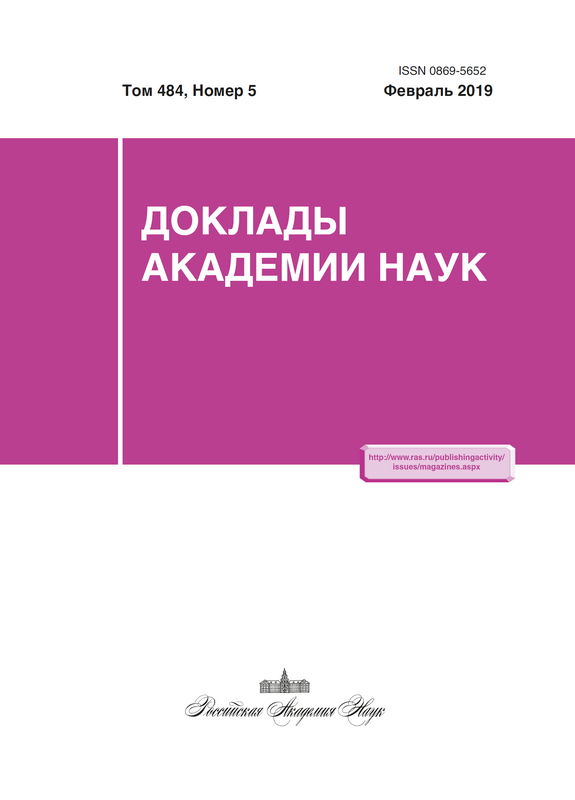Magnetic resonance imaging of water absorption by highly porous ceramic materials
- Authors: Morozov E.V.1, Bouznik V.M.2,3, Bespalov A.S.2, Graschenkov D.V.2
-
Affiliations:
- Krasnoyarsk Science Centre of the Siberian Branch of Russian Academy of Science$ Kirensky Institute of Physics of the Siberian Branch of Russian Academy of Science
- Federal State Unitary Enterprise All-Russian Scientific Research Institute of Aviation Materials State Research Center of the Russian Federation
- Gubkin Russian State University of Oil and Gas (National Research University)
- Issue: Vol 484, No 5 (2019)
- Pages: 563-567
- Section: Chemistry
- URL: https://journals.eco-vector.com/0869-5652/article/view/12772
- DOI: https://doi.org/10.31857/S0869-56524845563-567
- ID: 12772
Cite item
Abstract
By using the magnetic resonance imaging method the nontrivial character of water absorption was demonstrated for the first time in highly porous ceramic materials. The effect of hygroscopic memory was found out which is that the preferable concentration of absorbed water in certain areas within the sample persists regardless the subsequent sample wetting history. Coating the oxide fibres with fluorine-containing hydrocarbons in supercritical CO2 in order to hydrophobize the material has been shown to affect substantially the water transport within the sample that can be referred to as an effective approach to protect the porous materials from humid environment. The results obtained demonstrate the advantages of the magnetic resonance imaging in studying the water absorption processes and visualization of water pathways in highly porous ceramic materials.
About the authors
E. V. Morozov
Krasnoyarsk Science Centre of the Siberian Branch of Russian Academy of Science$ Kirensky Institute of Physics of the Siberian Branch of Russian Academy of Science
Author for correspondence.
Email: morozovev@iph.krasn.ru
Russian Federation, 50, Akademgorodok, Krasnoyarsk, 660036; 50, Akademgorodok, Krasnoyarsk, 660036
V. M. Bouznik
Federal State Unitary Enterprise All-Russian Scientific Research Institute of Aviation Materials State Research Center of the Russian Federation; Gubkin Russian State University of Oil and Gas (National Research University)
Email: morozovev@iph.krasn.ru
Academician of the RAS
Russian Federation, 105005, Moscow, Radio street, 17; 65, Leninsky prospect, Moscow, 119991A. S. Bespalov
Federal State Unitary Enterprise All-Russian Scientific Research Institute of Aviation Materials State Research Center of the Russian Federation
Email: morozovev@iph.krasn.ru
Russian Federation, 105005, Moscow, Radio street, 17
D. V. Graschenkov
Federal State Unitary Enterprise All-Russian Scientific Research Institute of Aviation Materials State Research Center of the Russian Federation
Email: morozovev@iph.krasn.ru
Russian Federation, 105005, Moscow, Radio street, 17
References
- Морозов Е.В., Коптюг И. В.,Бузник В.М. // Авиац. материалы и технологии. 2014. Т. 5. № S1. С. 17–29.
- Авилова И.А., Бузник В.М., Волков В.И., Железина Г.Ф., Морозов Е.В., Раскутин А.Е., Фалалеев О.В. // Авиац. материалы и технологии. 2014. Т. 5. № S1. С. 30–36.
- Koptyug I.V. // Progress in Nucl. Magn. Resonance Spectrosc. 2012. V. 65. P. 1–65.
- Китаева Н.С., Муханова Е.Е., Деев И.С. // Авиац. материалы и технологии. 2013. Т. S1. С. 125–130.
- Бузник В.М. // Авиац. материалы и технологии. 2013. Т. 1. № 26. С. 29–34.
- Беспалов А.С., Бузник В.М., Гращенков Д.В., Никитин Л.Н., Иванов В.К., Лебедь В.О., Чащин И.С. //Неорган. материалы. 2016. Т. 52. № 4. С. 431–437.
- Беспалов А.С., Каблов Е.Н., Гращенков Д.В., Чащин И.С., Бузник В.М., Никитин Л.Н. Гидрофобный пористый керамический материал и способ его получения. Пат. РФ №2630523. // Бюлл. 2016.
- Sahimi M. Flow and Transport in Porous Media and Fractured Rock: From Classical Methods to Modern Approaches. 2nd ed. Weinheim: Wiley-VCH, 2011. 709 p.
- Parlar M., Yortsos Y.C. // J. Colloid and Interface Sci. 1988. V. 124. № 1. P. 162–176.
Supplementary files







